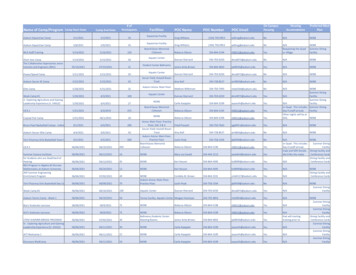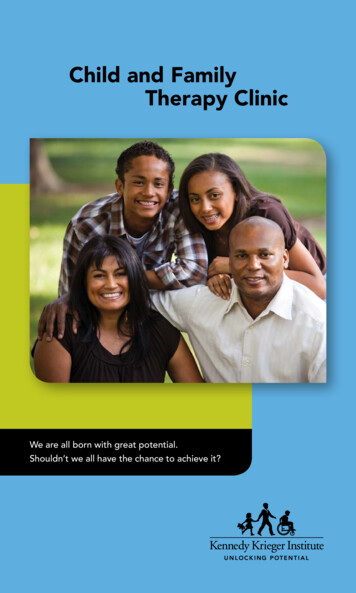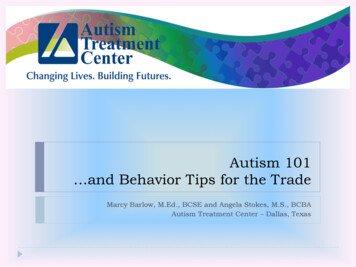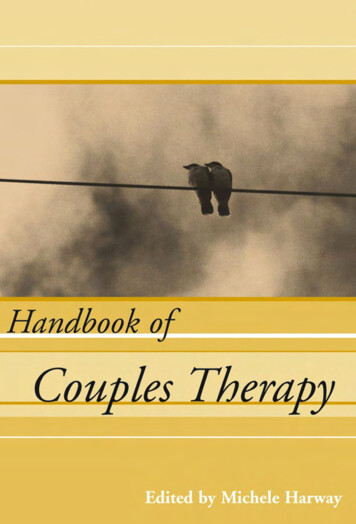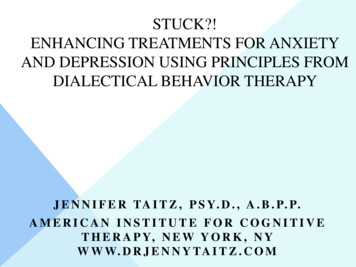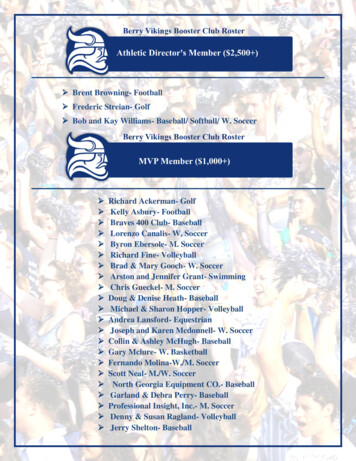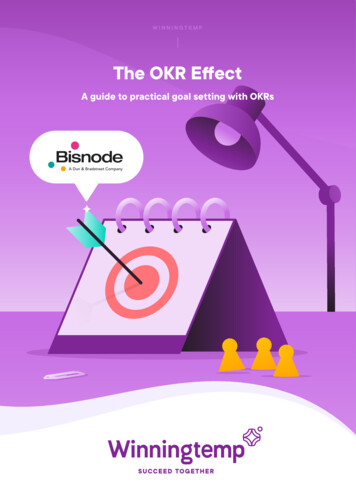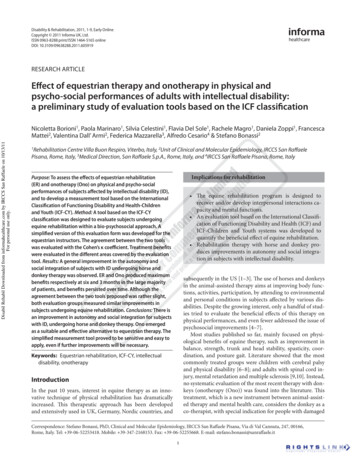
Transcription
Disability & Rehabilitation, 2011, 1-9, Early OnlineCopyright 2011 Informa UK, Ltd.ISSN 0963-8288 print/ISSN 1464-5165 onlineDOI: 10.3109/09638288.2011.605919RESEARCH ARTICLEEffect of equestrian therapy and onotherapy in physical andpsycho-social performances of adults with intellectual disability:a preliminary study of evaluation tools based on the ICF classificationDisabil Rehabil Downloaded from informahealthcare.com by IRCCS San Raffaele on 10/13/11For personal use only.Nicoletta Borioni1, Paola Marinaro1, Silvia Celestini1, Flavia Del Sole1, Rachele Magro1, Daniela Zoppi1, FrancescaMattei2, Valentina Dall’ Armi2, Federica Mazzarella3, Alfredo Cesario4 & Stefano Bonassi21Rehabilitation Centre Villa Buon Respiro, Viterbo, Italy, 2Unit of Clinical and Molecular Epidemiology, IRCCS San RaffaelePisana, Rome, Italy, 3Medical Direction, San Raffaele S.p.A., Rome, Italy, and 4IRCCS San Raffaele Pisana, Rome, ItalyImplications for rehabilitationPurpose: To assess the effects of equestrian rehabilitation(ER) and onotherapy (Ono) on physical and psycho-socialperformances of subjects affected by intellectual disability (ID),and to develop a measurement tool based on the InternationalClassification of Functioning Disability and Health-Childrenand Youth (ICF-CY). Method: A tool based on the ICF-CYclassification was designed to evaluate subjects undergoingequine rehabilitation within a bio-psychosocial approach. Asimplified version of this evaluation form was developed for theequestrian instructors. The agreement between the two toolswas evaluated with the Cohen’s κ coefficient. Treatment benefitswere evaluated in the different areas covered by the evaluationtool. Results: A general improvement in the autonomy andsocial integration of subjects with ID undergoing horse anddonkey therapy was observed. ER and Ono produced maximumbenefits respectively at six and 3 months in the large majorityof patients, and benefits persisted over time. Although theagreement between the two tools proposed was rather slight,both evaluation groups measured similar improvements insubjects undergoing equine rehabilitation. Conclusions: There isan improvement in autonomy and social integration for subjectswith ID, undergoing horse and donkey therapy. Ono emergedas a suitable and effective alternative to equestrian therapy. Thesimplified measurement tool proved to be sensitive and easy toapply, even if further improvements will be necessary. The equine rehabilitation program is designed torecover and/or develop interpersonal interactions capacity and mental functions. An evaluation tool based on the International Classification of Functioning Disability and Health (ICF) andICF-Children and Youth systems was developed toquantify the beneficial effect of equine rehabilitation. Rehabilitation therapy with horse and donkey produces improvements in autonomy and social integration in subjects with intellectual disability.subsequently in the US [1–3]. The use of horses and donkeysin the animal-assisted therapy aims at improving body functions, activities, participation, by attending to environmentaland personal conditions in subjects affected by various disabilities. Despite the growing interest, only a handful of studies tried to evaluate the beneficial effects of this therapy onphysical performances, and even fewer addressed the issue ofpsychosocial improvements [4–7].Most studies published so far, mainly focused on physiological benefits of equine therapy, such as improvement inbalance, strength, trunk and head stability, spasticity, coordination, and posture gait. Literature showed that the mostcommonly treated groups were children with cerebral palsyand physical disability [6–8]; and adults with spinal cord injury, mental retardation and multiple sclerosis [9,10]. Instead,no systematic evaluation of the most recent therapy with donkeys (onotherapy (Ono)) was found into the literature. Thistreatment, which is a new instrument between animal-assisted therapy and mental health care, considers the donkey as aco-therapist, with special indication for people with damagedKeywords: equestrian rehabilitation, ICF-CY, intellectualdisability, onotherapyIntroductionIn the past 10 years, interest in equine therapy as an innovative technique of physical rehabilitation has dramaticallyincreased. This therapeutic approach has been developedand extensively used in UK, Germany, Nordic countries, andCorrespondence: Stefano Bonassi, PhD, Clinical and Molecular Epidemiology, IRCCS San Raffaele Pisana, Via di Val Cannuta, 247, 00166,Rome, Italy. Tel: 39-06-52253418. Mobile: 39-347-2168153. Fax: 39-06-52255668. E-mail: stefano.bonassi@sanraffaele.it1
Disabil Rehabil Downloaded from informahealthcare.com by IRCCS San Raffaele on 10/13/11For personal use only.2N. Borioni et al.psychomotor, emotional, communicative functions. Equestrian rehabilitation (ER) improves posture, balance, and overallfunction by decreasing muscle stiffness, improving head andtrunk postural control, and developing balance reactions intrunk. Also, equine therapy influences patient’s confidenceand feeling of pleasure by touching, stroking, grooming andgiving verbal commands to the horse/donkey. The strength ofthe helping relationship, characterized by warmth, empathy,trust, acceptance and elaboration, is the most powerful predictor of positive outcome [11].The general need of validated evaluation tools that properly assess functional changes in subjects undergoing equinetherapy was clearly emerged from the analysis of the literature.A further priority identified is the use of standard classification criteria for assessing functions, such as those reported inthe International Classification of Functioning Disability andHealth (ICF [12]). Recent papers on rehabilitation theoriessuggest that ICF may be regarded as a new paradigm whichhas integrated the individual model of disability with the social model of disability [13,14]. The emphasis on environmental factors and human functioning as well as the interactionbetween the two represents a revolution in the way we thinkabout rehabilitation.ICF is not a measurement tool but rather a classificationsystem, therefore the present research faces two challenges,translating measures of functional status and environmentalaspects into the ICF language [15], and managing major difficulties which prevent a reliable and standard measurement ofthe rehabilitation outcome. Among them, the heterogeneousinterpretation of terms describing therapeutic activities involving equines, the lack of common rehabilitation protocols, andthe poor sensitivity of the few available validation tools are themost critical issues. As a direct consequence of these limitations, no large scale trials have been performed so far [10,16].In order to fill the gaps emerging from the literature, a research program was started at Villa Buon Respiro in Viterbo,Italy, a rehabilitation centre specialized in equine therapy,finalized to (i) evaluate the beneficial effect of ER and Ono onadults with intellectual disability (ID) (ii) explore and assesstwo evaluation tools based on the ICF [12] and ICF-CY classification [17], for personnel with psychological training andfor equestrian instructors, respectively. We decided to use alsothe ICF-CY classification in order to gather as many information as possible, given its wider and more complete range oftools. Furthermore, the use of the ICF-CY classification willfacilitate the use of these tools in children undergoing ER.Materials and methodsStudy design and subjectsAn evaluation tool based on the ICF and ICF-CY classificationsystem was developed by a team composed of neurologists,psychiatrists, psychologists, and all equestrian instructors (professionals specialized in ER). This tool aimed at measuring thehealth condition and domains of subjects undergoing equinerehabilitation according to relevant items reported in the ICF.Most of the evaluation features included in this evaluationtool were designed to be applied only by personnel withpsychological training (Tool A), and therefore, a simplified version of this list, after removing neuro-psychological items, wasdeveloped for the use of all therapists involved in the rehabilitation program (Tool B). A copy of these tools, both for ER (ToolA-ER; Tool B-ER) and for Ono (Tool A-Ono; Tool B-Ono),can be downloaded from the official website of the rehabilitation centre ni.asp?hw 12&id reparto 703). The first aim of the analysis wasto assess the degree of concordance between the two evaluationtools in measuring the improvement of selected abilities in adultswith ID. The comparative evaluation was performed in a groupof subjects undergoing Ono (at the beginning of the study, after3 months, 6 months, and 12 months), and in a smaller groupundergoing ER (at the beginning of the study, after 6 months, 12months, and 18 months). The assessment of individual performances was done independently and blindly between personnel with psychological training and equestrian instructors. Theperformance of the two tools was also compared in the differentareas covered by the evaluation program. Finally, the timing atwhich the improvements were observed and their persistenceover time were evaluated.Eight adult individuals undergoing equine therapy withhorses (ER) (mean age 42.9; SD 1.5), and fifteen individuals undergoing therapy with donkeys (Ono) (mean age 38.6;SD 8.6) were evaluated with both the functioning measurement tools over time. No changes were expected in the cognitivestatus of subjects included in the study, given their adult age.No external controls were recruited and performance at T0 wasconsidered as reference. In the group undergoing Ono, therewere two subjects affected by slight (13.3%), nine affected bymoderate (60.0%), and four by severe intellectual impairment(26.7%); in the ER sample, one subject was affected by slight(12.5%), five by moderate (62.5%), and two by severe intellectualimpairment (25.0%). Some selected clinical and demographiccharacteristics of the two study groups are summarized inTable I. The extent of intellectual impairment was assessed atthe beginning of treatment by a psychiatrist and a psychologistthrough a physical examination and a clinical interview with theuse of the Vineland Adaptive Behavior Scale [18]. All measurements were performed independently by psychologists and byTable I. Characteristics of the two study groups undergoing equestrianrehabilitation.Equestrianrehabilitation OnotherapyN Age (mean)SexEnvironmentIntellectual y & Rehabilitation
Equine rehabilitation in intellectual disabilityDisabil Rehabil Downloaded from informahealthcare.com by IRCCS San Raffaele on 10/13/11For personal use only.therapists of the rehabilitation team at Villa Buon Respiro. Allsubjects included in the research group or their tutors gave theauthorization to process personal data.Evaluation tools development and descriptionAfter identifying the specific goals of the ER and Ono, the rehabilitation team proceeded to select those ICF and ICF-CYcodes that best describe the functions and domains of the rehabilitation with horses and donkeys. The codes identified wereoperationally declined into specific items relating to the rehabilitative activities carried out at Villa Buon Respiro. The codesof the psychologists’ tool (Tool A) are very detailed, mainly of4 levels, while those of the instructors’ tool (Tool B) are morecomprehensive, mostly of 3 levels. The rehabilitation team alsofollowed the ICF-CY qualifiers, by considering those from 1 to 4in a decreasing scale. The qualifier “0” was assumed to mean noimpairment, so it was not included into the tools.Regarding ER, the Tool A-ER consists of 68 items overall.Ten of them were included to assess the area of autonomy, 20the motor-praxis area, 7 the neuro-psychological area, 17 theaffective-relational area, 5 the mental cognitive area, and 9 to assess communication. Tool B-ER is composed of 22 items overall,which excluding the neuro-psychological area, stated in a moreglobal and general way the same areas (Appendix 1).As regards Ono, the Tool A-Ono consists of 60 items overall, 10 of which assess autonomy, 11 the motor-praxis area, 7the neuro-psychological area, 18 the affective-relational area,4 the mental cognitive area, and 10 assessing communication.The Tool B-Ono is composed of 13 comprehensive items described in the Appendix 2.The list of the areas evaluated was compiled according todefinitions traditionally used at Villa Buon Respiro (althoughthe global reference paradigm was the ICF-CY classification)to simplify the participation of all professionals figures involved, especially in the building of the equestrian instructors’ tool.Equine therapyThe equine rehabilitation program is designed to recover and/or develop (1) interpersonal interactions capacity by involvingthe internal motivation, openness to experience and control ofemotions of the person and (2) mental functions by involvingmemory, psychomotor, higher-level cognitive and languagefunctions. The rehabilitation aim is to achieve the best levelof autonomy, both on individual and societal perspectives,improving self-esteem and enhancing communication/interactions with others.The equine rehabilitation treatment is based on two programs, with horses and donkeys.Therapy with horses (ER)Inspired by the findings from the International Congress onER in 1982, the rehabilitation program is articulated into threephases (1) hippotherapy, (2) equestrian re-education throughriding and vaulting, and (3) pre-sporting riding. The rehabilitation program implemented at Villa Buon Respiro includeda fourth stage, the horse carousel, which replaced the originalathletic stage.Copyright 2011 Informa UK Ltd.3Hippotherapy: It is a passive form of riding in which theperson benefits from the movement of the horse. Horse’s paceand rhythm break the pathological patterns such as stereotyped movements, isolation, postural rigidity and aggressivebehavior. During this activity, the instructor can relate withthe person and integrate the riding with movement on theground, i.e. horse handling.Equestrian re-education: It is characterized by a first phaseof approaching and a second one of learning with the finalaim of controlling the horse and making the person able toperform the riding alone. These steps allow to rehabilitatecognitive, emotional and psychomotor functions throughharness care, horse cleaning and relationship with the horse.Pre-sporting riding: The person develops the awarenessof riding as a sport. That means not only performance andcompetitiveness, but also a special relationship with thehorse and the full participation in riding activities along withnon-intellectual impaired people and interactions with theoutside world.Horse carousel: Villa Buon Respiro’s choice to replace theathletic stage with the horse carousel was made to ensure areal integration of the rehabilitated individuals. Differentlyfrom a competition, the horse carousel allows disabled peopleto work and perform together with other riders experiencingin this way, a real integration.Therapy with donkeys (Ono)This therapy uses the gentle nature of the donkey to facilitatethe recovery of spontaneous communication. This makes itan effective treatment especially, for people with affective andemotional disorders.The rehabilitation program is scheduled into three stages:(1) approaching and contact; (2) interaction with donkey; (3)making donkey respond to command.Statistical methodsThe agreement between two group of raters, i.e. psychologistsand instructors, was measured with the Cohen’s κ coefficient.According to Landis and Koch [19], if κ is smaller than 0.00,there is no agreement; values between 0.01 and 0.40 suggesta slight or fair agreement; between 0.41 and 0.60, a moderateagreement, while for values greater than 0.61, the agreementis substantial. κ equal to 1 indicates perfect concordance.To evaluate the effect of equine therapies, we defined oneindex that quantifies the change of subjects’ performance overbaseline, i.e. the baseline relative improvement, Ba. This statistics represents in each area of the evaluation scheme themean improvement during the period of treatment, i.e.ns Ba s 1 Basnswhere, Bas Fas Ias 100Ias
4N. Borioni et al.where,nanai 1i 1Disabil Rehabil Downloaded from informahealthcare.com by IRCCS San Raffaele on 10/13/11For personal use only.Fas max(ps ) and Ias pbisand, i item; a area; s subject; p score; pb baselinescore.A linear regression model was fitted to each therapy andeach group of raters to determine the treatment performanceover time within and between areas. Scatter plot and quantilequantile plot confirmed the normality of residuals. The timewhen a individual achieved the maximum score, per eachitem, was considered to evaluate the timing of the treatmenteffects. The persistence of these effects was evaluated according to the average frequency of subjects achieving their maximum score, and described with time-line plots.The critical limit for significance was fixed at 5%. Thesoftware used for the analysis was SPSS V.13.0 (SPSS Inc.,Chicago, IL, USA).ResultsERThe overall agreement between the psychologists’ and the instructors’ evaluation scores was rather slight, although in thecognitive area, the κ coefficient reached the value K 0.279(p 0.001). The poorest concordance was in the motorpraxis (K 0.122, p 0.001) and in the affective-relational(K 0.154, p 0.001) areas. The instructors gave lower scoresto individual performance, except for the autonomy area. Nocomparison between the two evaluators was possible for theneuro-psychological and communication areas, since the instructor’s tool did not include these parameters.A general improvement was observed in subjects undergoing rehabilitation with horses (Figure 1). In particular, thepsychologists observed significant improvements in autonomy ( Bau 31.4%, p 0.001), motor-praxis ( Bm p 18.5%,p 0.035), affective-relational ( Ba e 33.7%, p 0.001), andcognitive ( Bcog 41.6%, p 0.001) areas. On the other hand, theinstructors recorded improvements in autonomy ( Bau 39.9%,p 0.001), affective-relational ( Ba e 26.7%, p 0.002), andcognitive ( Bcog 55.2%, p 0.001) areas. Considering the areasof major psychological pertinence, an improvement over baseline was observed in neuro-psychological area ( Bn p 38.6%,p 0.001), while no evidence of improvement was reached inthe communication area ( Bcom 8.8%; p 1.000).The distribution of subjects’ performances over the studyperiod showed that 75% of individuals reached their best performance in most areas after 12 months of therapy. The onlyexception concerns the psychologists, which found the highest frequency of subject reaching the maximum score before6 months in communication and affective-relational areasFigure 1. Relative improvement over baseline (ΔRO%) by group of raters and area (*p 0.05; **p 0.01). (A) The improvement relative to theequestrian rehabilitation (ER). (B) The improvement relative to the onotherapy (Ono).Disability & Rehabilitation
Equine rehabilitation in intellectual disability5Table II. Frequency distribution of eight subjects undergoing equestrian rehabilitation according to the moment when they reach the maximum score, bygroup of raters and by area.AreasNumber of 0100.0100.0Disabil Rehabil Downloaded from informahealthcare.com by IRCCS San Raffaele on 10/13/11For personal use unication6 months% cum.%12 months% cum.%18 months% cum.Cum, cumulative.Figure 2. Trend over time of subjects performance, by area, rehabilitation protocol, and group of raters (A, Autonomy; B, Motor-praxis; C, Neuropsychological; D, Affective-relational; E, Cognitive; F, Communication). (A) and (B) The trend assessed for the ER, respectively by instructors andpsychologists. (C) and (D) The trend assessed for the Ono respectively by instructors and psychologists.(Table II). However, a significant improvement of mean scoreswas registered by both groups of evaluators in all areas after6 months from the start of rehabilitation treatment (Figure 2).OnotherapyThe agreement between psychologists and instructors rangedfrom slight to fair in the six areas considered. The area with thehighest concordance was communication (K 0.283, p 0.001),while the motor-praxis area showed the poorest inter-rater concordance (K 0.006, p 0.429), with psychologists providing amuch higher score for motor-practical ability. Instructors systematically rated the individual abilities lower.Copyright 2011 Informa UK Ltd.The relative improvement versus baseline is shownby group of raters and by area in Figure 1. Both groupsof raters reported a statistically significant improvementof individuals’ skills during treatment in all areas exceptmotor-praxis, where the psychologists didn’t report asignificant improvement ( Bm p 12.2%, p 0.103). Thepsychologists also reported a higher improvement in theautonomy, affective-relational and cognitive areas, whileinstructors scored higher improvements in motor-praxisand communication. The smaller number of subjects undergoing Ono resulted in a smaller number of statisticallysignificant results.
6N. Borioni et al.Table III. Frequency distribution of 15 subjects undergoing onotherapy according to the moment when they reach the maximum score, by group of raters andby area.AreasDisabil Rehabil Downloaded from informahealthcare.com by IRCCS San Raffaele on 10/13/11For personal use CognitiveCommunicationNumber of 120.011.3100.090.9100.098.5100.0100.0Further parameters to be evaluated were the timing inwhich the improvements were observed, and their persistenceover time. The majority of subjects reached their maximumimprovement 3 months after the start of the therapy almost ineach area for both group of raters (Table III). Two exceptionswere observed in the affective-relational and communicationareas, the instructors registered the individual maximumscore 12 months after the start of therapy, 21% and 40% ofsubjects, respectively. On the other hands, the psychologistsscored the best performance in the cognitive areas after 6months of treatment. To further explore the timing of subjects’ best performance, we set the moment when the 75% ofsubjects reached the maximum score as a threshold. For bothgroup of raters and for most areas, this value was reached at3 months, with a few exceptions, i.e. according to instructors,the maximum score in the affective-emotional and relationalarea was reached at 6 months, and in the communication area,12 months after the start of the rehabilitation program. On theother hand, the psychologists measured the maximum scorein the autonomy, neuro-psychological and cognitive areas after 6 months of treatment (Table III).As far as persistence is concerned, according to the instructors, the improvements remained constant after thethird month with the exception of the communication area,whereas the psychologists reported a constant increment inmost areas until 6 months. A different trend was observed inthe motor-praxis area, with stable scores up to sixth month,followed by a rapid decrease, and for the communication area,with scores decreasing from 3 to 6 months and then increasing again up to 12 months (Figure 2).DiscussionEquine rehabilitation successfully rehabilitates people with intellectual and learning disabilities. The horse/donkey movementand the non-clinical environment improve not only physical butalso mental, social, communication, and behavioral outcomes.Disabled people often develop a bond with the horse/donkeythat alleviates feelings of loneliness and isolation.The need of a reliable evaluation of benefits from ER onphysical and cognitive abilities of subjects with ID is a leading priority in the field. The assessment of suitable outcomes3 months% cum.%6 months% cum.%12 months% cum.to quantify the improvement, and the development of validated tools of evaluation, are the two major milestones. Inthis manuscript, we presented the results of a double analysiscomparing psychologists and equestrian instructors, as wellas and ER vs. Ono.The first aim of the study was to evaluate the beneficial effect of equine rehabilitation with horse and donkey on physical and psycho-social performances of adults with ID.The study results showed that both psychologists and instructors recorded a significant improvement in the autonomy,cognitive and affective-relational areas in ER. These findingsconfirmed the suitability of the tool developed by the authorsto register behavioral changes in the study subjects, as well asthe beneficial effect of treatment. Furthermore, the study provided a basic information useful for the planning of individualrehabilitation programs, which is the time required to get thetreatment effect. The highest performance was reached after12 months of therapy with the exception of the communication and affective-relational areas rated by psychologists whichfound the best performance before 6 months.As regards Ono, the evaluation of psychologists and instructors was quite different. The psychologists recorded significantimprovements in autonomy, affective-relational and cognitiveareas, in contrast with the instructors scores, which emphasizes the improvement in the motor-praxis and communicationareas. The highest improvement was reached for both ratersat 3 months with a few exception. As far as the persistenceof benefits over time is concerned, the instructors reporteda constant increasing trend after the third month, while thepsychologists after 6 months.The results of this study showed that both horse and donkey therapies help disabled people to become more aware ofthe surrounding environment, thanks to the consistent reaction of the animal to patient’s actions. This controlled interaction allows the patient to engage his mind and to lengthen theattention span and focus. Horse and donkey also providepositive acceptance and increase confidence and self-esteemin the patient which enhances the level of participation.The difficulty of measuring the effect of equine rehabilitation, along with the need of standard classification criteriafor assessing outcomes, was the second aim of the study. Twonew measurement tools, based on the ICF-CY classification,Disability & Rehabilitation
Disabil Rehabil Downloaded from informahealthcare.com by IRCCS San Raffaele on 10/13/11For personal use only.Equine rehabilitation in intellectual disabilitywere developed for the use of the equestrian rehabilitativeteam, under the assumption that validation procedures are afundamental part of rehabilitation programs, and that all thepersonnel should be involved in this activity. As a first step,the two tools developed to be applied by psychologists (ToolA) and the simplified version of this schedule (lacking of theneuro-psychological items) for all the rehabilitation team(Tool B), were tested. The simpler version of the tool was validated by measuring the degree of concordance between thetwo evaluation teams. Regarding horse therapy, the agreementbetween psychologists’ and instructors’ tool resulted ratherslight, except for the cognitive area, where the concordancewas fair (K 0.28). The instructors showed the trend to givelower scores than psychologists, except for the autonomy area.Regarding donkey therapy, the agreement ranged from slightto fair and the score trend was the same with the instructorsgiving lower scores. The area with the highest concordancewas communication (K 0.28).The results showed that the protocol developed for psychologists was more sensitive and complete than that designed for instructors, given the specific expertise of raters.However, routine practice is usually performed by instructors, and the validation of a measurement tool suitable forthis group would represent a valuable means in the planningand evaluation of the equine rehabilitation programs. Theresults showed the presence of a slight agreement betweenpsychologists and instructors in detecting individual improvements during the treatment, although there was acertain discordance concerning the degree of improvement.It’s to underline that the number of items of the instructors’measurement tool was much smaller than the psychologists’one (i.e. respectively 2 items vs. 10 items in the communication area and 10 items vs. 19 in the motor-praxis area). Oneof the basic assumption of the study was to adopt the ICF toassess functional status, treatment monitoring, and outcomemeasurement. The ICF is WHO’s framework for measuringhealth and disability at both individual and population levels,and it is endorsed as the International standard to describeand clas
ological benefits of equine therapy, such as improvement in balance, strength, trunk and head stability, spasticity, coor-commonly treated groups were children with cerebral palsy and physical disabi
